| Antonio Perosio
(1849-1893), was son of Francesco Perosio
and Luigia Bondanza, born in Ronco
Scrivia, Genoa.
Ronco Scrivia has more than 200 year like
“Comune” but it have almost millennial history,
as he also testifies him their Ronco name, of medieval latin
“runcare”, what means to plow the uncultured lands.
The city this divided in two parts by the torrent Scrivia,
for the freeway and for the ferroway. Ronco is presented like
a great extension of low houses among mounts not very high:
the highest is the Real Mount (902 meters.)
|
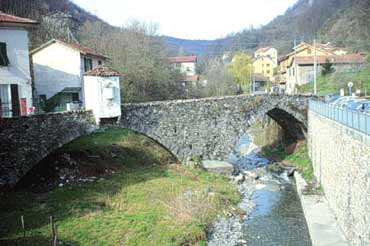
Ronco Scrivia. |
| The part but old of the city
it is Villavecchia that is recognized by the typical built
houses one hit to the other one. In this area we find a Roman
bridge and the Vía Postumia that in a time Genoa united
with Aquileia going by Libarna whose excavations today they
constitute the main archaeological place of the Under Piamonte...
For the lack of possibilities of progress
in their earth, perhaps incentivated by the previous departure
toward South America of the family, (See The
firsts Perosio in the “Río de la Plata”),
he decides little time later to also emigrate to Uruguay,
settling down in the Departament Artigas, to the north of
the Oriental Republic of the Uruguay.
In Italy they were their parents and siblings
Stefano Celestino and Rosa... Almost fifty years later sons
of Stefano Celestino (Antonio's brother) they would emigrate
to Buenos Aires, Argentina…
Artigas is one of the departments of Uruguay,
in the northwest of the country. Limit to the north and the
east with the Brazilian frontier, to the west with Argentina
by means of the river Uruguay, and to the south with the department
of Salto. Inside a country plain, is dominantly a department
of hills or plateaus (snub), of volcanic, basaltic lavas,
of Jurassic and cretacic age, whose back gives a soft slope
toward the river Uruguay, while to the east it presents a
clipped front. In her some alignments of mountains denominated
kitchen knives rise (kitchen knives of Nativity, of Yacaré,
of Tres Cruces and Sepulcro), among those that prepare other
so many valleys for where streams reflect (Itacumbú,
Naquiná ) and the river Arapey that will give to the
river directly Uruguay, and others to the Cuareim river that
serves as Brazilian frontier. |
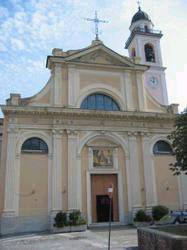
Church San Martino Vescovo. |
| In August of 1847 it had
arrived to Artigas the Uruguayan general Diego Lamas you Lick
who settles later at the moment in “Tres Cruces”
and few months in the Step of the department of Big Cuaró
to stop the frequent territorial intrusions of the Brazilian
baron Yacuhy.
For that time a called basque Vicente
Saralegui that passed to occupy absent proprietors'
lands located among the stream Cuaró and the river
Arapey also arrives.
It is possible that Saralegui commented to
a called young basque José Artola Martinicorena clerk
in Montevideo in the company Taranco, the sale of fields in
the place.
José Artola acquired in 1870 one of
those fields installing a called ranch Cuaró.
Murdered Vicente Saralegui cruelly, they
continued the exploitation their sons Zacarías, Lorenzo
and Miguel Saralegui and arrived of Spain their son-in-law
José López Saralegui, solved to establish a
society with José Artola proprietor of the ranch Cuaró
called Artola-Lopez Saralegui. |
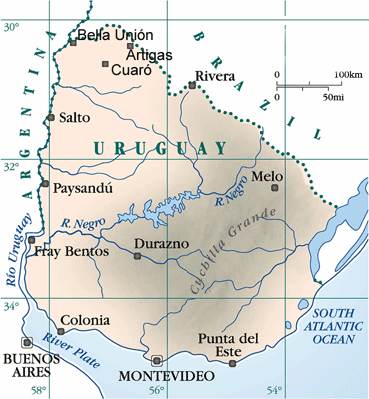
Uruguay. |
| Cuaró was the point
forced for where they passed most of the merchandises in commercial
traffic with Brazil.
José Artola Martinicorena
as one of the first farmers of Artigas that worried about
the improvement of the races of sheep, import from 1884 valuable
exemplary merino Vermonth from United States. Some years later
their ranchs and mainly the renowned ranch Cuaró, provided
from reproducers to cattlemen of the Uruguayan north.
The quality of the wools that they gathered
was recognized in Europe to where they exported, remitting
it with the label of Wool of Cuaró or Merino Cuaro,
the one that produced bigger percentage in the hairstyle due
to its looseness that that of the rest of Uruguay.
|
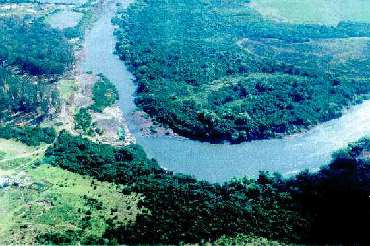
Cuareim River. |
José Artola was a progressive man that knew
how to administer his cattle production, stimulating and rewarding
collaborators that he brought of Basque counties, enabling
them according to habit.
The society didn't only bring manpower qualified
in the sheep breeding, mainly arrival from the villages of
Errazquin, Inza and Betelú; it also claimed the presence
of Basque youths as women for service of their families, but
with the main objective of achieving marriages among the Basque
immigrants.
Antonio Perosio
(1849-1893) settles down before in the area like blacksmith
in the ranch mentioned, there he knows one of José
Artola Martinicorena sisters, named Fermina Artola
Martinicorena, born in Errazquin Basque country
with who marries in the church of Santa Rosa's population,
current “Bella Union”, November 23, 1875 and it
dies February 8, 1893 in Yucutujá, Depto.de Artigas.
|
They had five children:
Footnotes: For characteristic of the epoch
errors, the last name had deformed and his recorded descendants
as Perossio.
-
Francisco Perossio Artola
(1876-1939), a landed man, married with Josefa Beraza
Artola, in Errazquin, Basque Country; they had 9 children:
a) Francisco; b) Felipe; c) Josefa; d) Elena; e) María;
f) Rosa; g) Ema; h) Nieves and i) Juan Perossio Beraza.
-
Maxima Perossio Artola
(1878-1970), married with Aquiles Lucini Manani March
23 1899 in Cuaró, 9 children: a) Camilo; b) Fermina,
c) Victorio; d) María; e) Casimiro; f) Crispín;
g) Ursula; h) Antonio and i) Julio Lucini Perossio.
-
Petrona Perossio Artola,
born in 1880, married with Miguel Soravilla Ochonarena,
7 children: a) Juan; b) Severina; c) Demetrio; d) María;
e) Francisca; f) Benito and g) Miguel Soravilla Perossio.
-
Luisa Perossio Artola
born July of 1882, 27,married with Pablo Riva, one children.
-
Fermina Perossio Artola,
born May of 1885, 12. Married in 1906 Maximo Severino
Ramos.
|
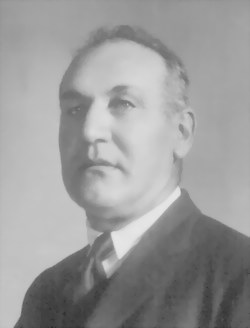
Francisco Perossio Artola. |
|